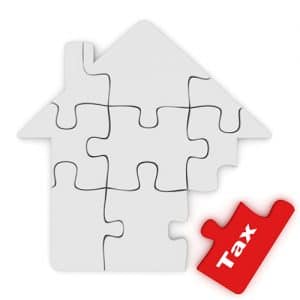A Complete Guide to Capital Gains Tax
Introduction
The thing about property investing is that eventually you, or your beneficiaries if you hold for the extremely long-term, will likely have to pay Capital Gains Tax (CGT).
This is the time when the Federal Government gets their share of the profit that you’ve made from investing in property as it’s technically classed as personal income.
So, in this article we’ll outline what CGT is, how to minimise it, and how to calculate it, so no one’s surprised when the taxman (or woman) comes a-calling.
What is Capital Gains Tax?

Capital Gains Tax was introduced in Australia in 1985 and applies to any asset you’ve acquired since that time, unless specifically exempted.
According to the Australian Tax Office, a capital gain or capital loss on an asset is the difference between what it cost you and what you receive when you dispose of it.
You pay tax on your capital gains, which forms part of your income tax and is not considered a separate tax – though it’s referred to as CGT.
If an asset is held for at least one year, then any gain is first discounted by 50 per cent for individual taxpayers or by 33.3 per cent for superannuation funds.
Capital losses can be offset against capital gains, and net capital losses in a tax year may be carried forward indefinitely. However, capital losses cannot be offset against normal income.
According to the ATO capital gains tax, most personal assets are exempt from CGT, including your home, car, and most personal use assets such as furniture. Capital Gains Tax also doesn’t apply to depreciating assets used solely for taxable purposes, such as business equipment or fittings in a rental property.
If you’re an Australian resident, Capital Gains Tax applies to your assets anywhere in the world. Foreign residents make a capital gain or capital loss if a CGT event happens to an asset that is ‘taxable Australian property’.
When you sell or otherwise dispose of an asset it’s called a Capital Gains Tax event, which is the moment when you make a capital gain or capital loss.
It’s also important to establish the timing of a CGT event because it tells you in which income year to report your capital gain or capital loss, and may affect how you calculate your tax liability.
If you dispose of a CGT asset, the CGT event usually happens when you enter into the contract for disposal. In the case of real estate, for example, the CGT event generally occurs when you enter into the contract – that is, the date on the contract, not when you settle.
How Much is Capital Gains Tax?
The vast majority of people pay Capital Gains Tax on a rental property when they sell, or dispose, of it, so it’s important to understand how CGT is calculated.
CGT can be a little tricky to calculate, that’s why it’s so important to have specialists on your side – and especially a good taxation accountant.
Remember CGT is only payable in the financial year in which you sell or dispose of your rental property. So, if you follow a long-term wealth creation strategy you won’t need to worry about paying this for many years or possibly decades. In the meantime, you can access any capital growth to grow your portfolio and improve your overall financial position.
For most CGT events, your capital gain is the difference between your capital proceeds and the cost base of your CGT asset – that is, where you receive more for an asset than it cost you.
According to the ATO, the cost base of a CGT asset is largely what you paid for it, together with some other costs associated with acquiring, holding and disposing of it.
If the rental property or asset was acquired before 1985, then no CGT is payable, however, major improvements to a property since that time may be subject to CGT.
There are three options to calculate your capital gain. You can choose the method that gives you the best result (that is, the smallest capital gain) as long as you satisfy certain conditions.
The three different calculations are:
CGT discount method
For assets held for 12 months or more before the relevant CGT event. Allows you to reduce your capital gain by:
- 50 per cent for individuals (including partners in partnerships) and trusts
- 3 per cent for complying super funds.
This is generally not available to companies.
Indexation method
For assets acquired before 11.45am (by legal time in the ACT) on 21 September 1999 (and held for 12 months or more before the relevant CGT event).
- Allows you to increase the cost base by applying an indexation factor based on the consumer price index (CPI) up to September 1999.
Other method
For assets held for less than 12 months before the relevant CGT event. To determine whether you acquired the asset at least 12 months before the CGT event, exclude both the day of acquisition and the day of the CGT event.
- Basic method of subtracting the cost base from the capital proceeds.
An example of using the CGT discount method is:
Julie buys a rental property on 1 June 2014 for $300,000 and sells it for $350,000 on 15 July 2015. As she owned the asset for more than 12 months she is entitled to the 50 per cent CGT discount. She would need to also subtract the cost base from the capital proceeds, deduct any capital losses, then reduce by the relevant discount percentage.
There are a number of Capital Gains Tax calculators available online so you can work out how much CGT you might have to pay if you sell a rental property.
It’s important, of course, to use a specialist taxation accountant when it comes to time to lodge your tax return for the financial year in which you’ve disposed of the asset.
Avoiding Capital Gains Tax by living in the Property
When it comes to property, one of the major exemptions from Capital Gain Tax is if it’s your home or principal place of residence (PPOR).
You can generally claim the main residence exemption from CGT for your home. To get the exemption, the property must have a dwelling on it and you must have lived in it. You’re not entitled to the exemption for a vacant block.
Generally, a dwelling is considered to be your main residence if:
- You and your family live in it.
- Your personal belongings are in it.
- It is the address your mail is delivered to.
- It is your address on the electoral roll, and
- Services such as phone, gas and power are connected.
There is also a tax break which you may be able to access if your PPOR becomes a rental property.
There is a special six-year rule, which means that a property that was previously your PPOR can continue to be exempt from CGT if sold within six years of first being rented out.
The exemption is only available where no other property is nominated as your main residence.
What’s interesting about this rule is that if the same dwelling is reoccupied as your main residence, then the six-year exemption resets. So another six years of exemption is available from the date it next becomes income-producing.
Paying Capital Gains Tax if your main residence is used for business
Advancements in technology means that more and more people are working either from home or working for themselves.
A tax issue that many people find themselves in, however, is that if they work from home or use they home for business purposes, that may trigger some form of CGT.
It’s important to understand that if your employer has an office in the city or town where you live, your home office will not be a place of business, even if your work requires you to work outside normal business hours.
Also if your income includes personal services income, you may not be able to claim a deduction for occupancy expenses.
According to the ATO, it’s important to consider any CGT impacts of claiming your home as a business premises.
To work out the capital gain that is not exempt, you need to take into account a number of factors including:
- Proportion of the floor area of your home that is set aside to produce income.
- Period you use it for this purpose.
- Whether you’re eligible for the “absence” or six-year rule
- Whether it was first used to produce income after 20 August 1996.
Avoiding Capital Gains Tax with a Self-Managed Super Fund
 The ability to borrow money to invest in property, in particular, by using the mechanism of a SMSF has resulted in the number of funds increase rapidly in recent years. Close to 600,000 SMSFs are now in operation, according to the latest statistics released by the Australian Taxation Office (for December 2015).
The ability to borrow money to invest in property, in particular, by using the mechanism of a SMSF has resulted in the number of funds increase rapidly in recent years. Close to 600,000 SMSFs are now in operation, according to the latest statistics released by the Australian Taxation Office (for December 2015).
While people have generally always been able to buy property through SMSFs, what has changed in the past few years is that SMSFs can now borrow money to do so.
Buying a property through a SMSF should not be the sole reason that someone chooses to set up a SMSF but it can be an option for people who want more control over their super.
Similarly it’s important to not consider buying property with a SMSF solely as a way to avoid, or minimise, paying CGT. It should work for your long-term investment strategy as well as meet a number of checks and balances for your financial future.
If you do choose to invest in property using a SMSF, the unique ownership structure provides a number of taxation benefits. If you sell the property once you’ve retired, you’ll pay no capital gains on the property. There’s also a 33 per cent discount available under the CGT discount method calculation.
Borrowing or gearing your super into property must be done under very strict borrowing conditions and can present investment risks.
Some of the property risks associated with geared real estate bought via a SMSF include:
- Higher costs – SMSF property loans can be more costly than other property loans, which must be factored into your investment decision.
- Cash flow– Loan repayments must be made from your SMSF, which means your fund must always have sufficient liquidity or cash flow to meet the loan repayments.
- Hard to cancel– If your SMSF property loan documentation and contract is not set up correctly unwinding the arrangement may not be allowed and you may be required to sell the property, potentially causing substantial losses to the SMSF.
- Possible tax losses– Any tax losses from the property cannot be offset against your taxable income outside the fund.
- No alterations to the property– Until the SMSF property loan is paid off alterations to a property cannot be made if they change the character of the property.
Intuitive Finance – the smart choice
As this article has outlined, the world of investing in property and property taxation can be complex so it’s vitally important that you have a professional team on your side to help your financial dreams become a reality.
Now more than ever, you need investor savvy people working on your financial side, who can help you navigate the ins and outs of Capital Gains Tax and point you in the right direction to access expert taxation advice and assistance. It’s also important to always do your own research about Capital Gains Tax to better understand what your financial liability may be should you sell a rental property.
The world of banking and finance can be a pretty daunting one for both novice and sophisticated investors and since our establishment in 2002 we’ve focused on providing outstanding service and business standards.
This approach was vindicated when we were recently named Victoria’s favourite mortgage broker at the 2015 Investors Choice Awards.
If you’re considering investing in property and want to learn more about Capital Gains Tax and how it may impact you, contact Intuitive Finance to ensure you have the right information and expert support on your side from the very beginning.
The information provided in this article is general in nature and does not constitute personal financial advice. The information has been prepared without taking into account your personal objectives, financial situation or needs. Before acting on any information you should consider the appropriateness of the information with regard to your objectives, financial situation and needs.
- Investment Property Financing: Interest-Only vs Principal and Interest Loans - November 18, 2025
- Serviceability vs. affordability – What’s the difference and how does it affect me? - October 14, 2025
- Why three quality properties beat thirty average ones - September 15, 2025

